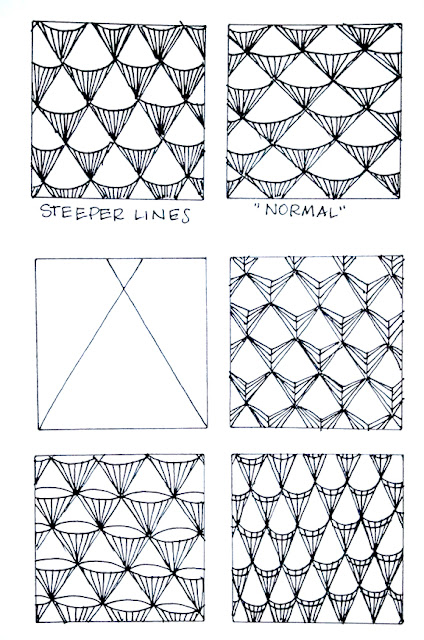I tinkered with a new pattern today! The deconstruction was was easy enough, but it took me forever to figure out how to space out the dots so the end result looked right. Anyway, *here* is the source of my euphoria, from a book of Japanese paper.
Here goes nothin'.
Columns of dots... pretty simple. This is going to be a staggered grid when it grows up, but I'm drawing it in columns becaaaaause...
(you should know that over a dozen index cards and a ridiculous amount of red ink have sacrificed themselves so I could impart this wisdom to you.)
...if you want your final pattern to look like the 'starburst' pattern above, your dots must be much farther apart horizontally than they are vertically. I tried this pattern several times over with similar (terrible) results, before I finally got that. I kept drawing a square grid without even realizing what I was doing wrong *smacks forehead*
Here's why the spacing is important:
Notice that in both A and B the distance between the rows is the same, but the columns are twice as far apart.
I promise, once you get this part down, the rest is cake.
::2::
In case you're wondering why this part takes two steps, my staggered grids and regular dot grids always start off the same way. For a staggered dot grid, I just draw all of the dots a little further apart and then go back and add the offset dots in between. This method helps to keep everything spaced out evenly.
That's another cookie trick.
If you don't need/want to use this method, you can ignore it, pass go, collect $200, keep calm and tangle on, go raid the fridge, et cetera.
::3::
Told you the rest was easier.
::4::
The simplest way to do this part is to draw all the lines going in the same direction, turn your tile, and then do all the lines going in the opposite direction. I didn't actually remember that until after it was finished.
Zig-zagging works too.
The columns of dots (hey, let's call them power pellets!!) below aren't as spaced out as they should be, but since the red ink and the black ink are both in the right place, I'm gonna call that a win.
::5::
Draw from the middle of each triangular space to each corner. I go through first and put a dot in the center to anchor my lines (as you can see above) but I freely admit this is probably not necessary. If you do it, make sure it's small enough that a single line will conceal it.
Use slow, deliberate strokes. Try to be precise at the center of each triangle, because there is no good way to conceal mistakes there. Also, try to be precise when attaching your lines to the dots in the grid because there are a lot of lines converging there. If they don't meet at the right spot, it's possible to end up with some distracting white gaps or dark spots in your final pattern.
The end result:
And as a border:
Now that we've figured out the rules, let's break a few!
with extra dottiness
with some extra outlining here and there
buncha lines as shading.
a moderately successful attempt at Rick's Paradox.
with an oversized dot grid
with double lines.
with a very unobtrusive dot grid.
with wavy lines.
with lots of aura action.
with skinny football shapes replacing the lines in the Y
with skinny football shapes replacing ALL of the lines
•••••••••••••••••••••••••••••••••••••••••••••••••••••••••••••••••••••••••••••••••••••••••••••
I love this variation so much that he gets his own name.
This is WUNDERMUTT. His parents are WUNDERWALL and N'ZEPPEL. Ooh, I love it when a plan comes together!
The steps are the same as Wunderwall except you draw the 'squished balloons' in the triangles before you add the Ys in the middle.
Remember the lines in Y stop short and do not continue on to the dot, or the rounding effect is ruined.
Blogger's note:
If you would like to try a very different approach to drawing a pattern that looks similar to Wunderwall, get your paws on a copy of 'Totally Tangled' by Sandy Steen Bartholomew and check out HEMP.
If you're comfortable with the method outlined above, get the book anyway. Fifty pages of unique patterns, tips, and ideas... it's one of those books you can't resist flipping through. Repeatedly.
Happy tangling!



















































